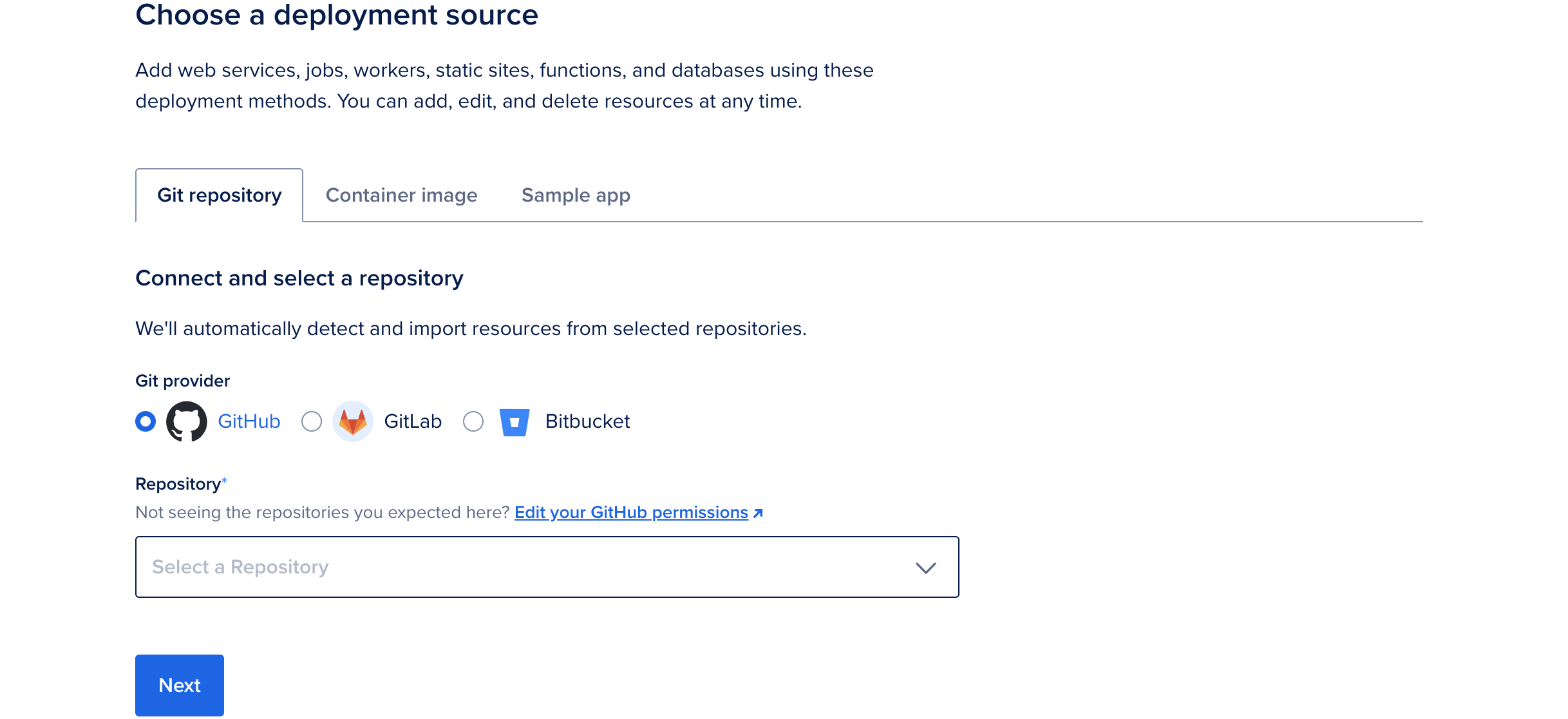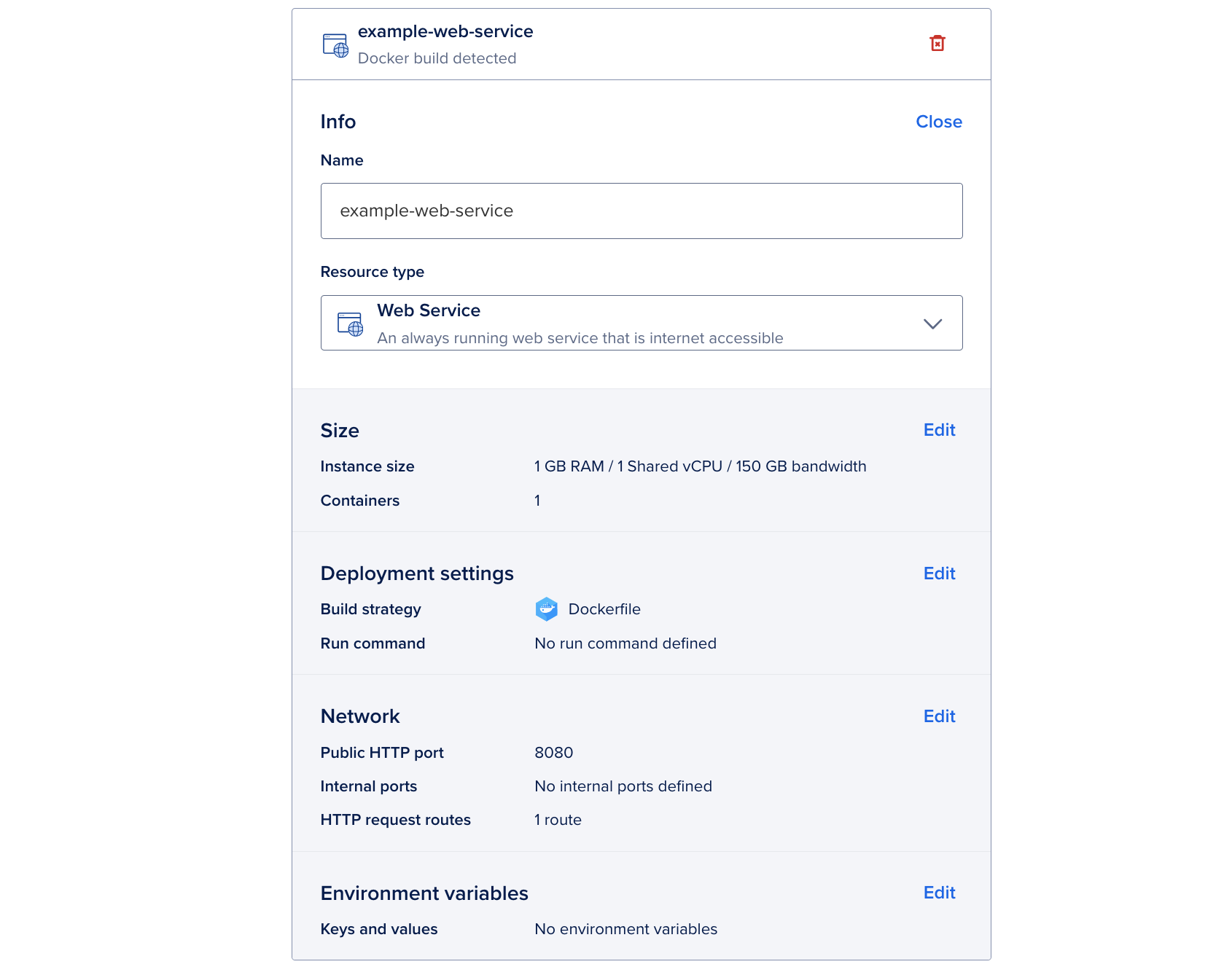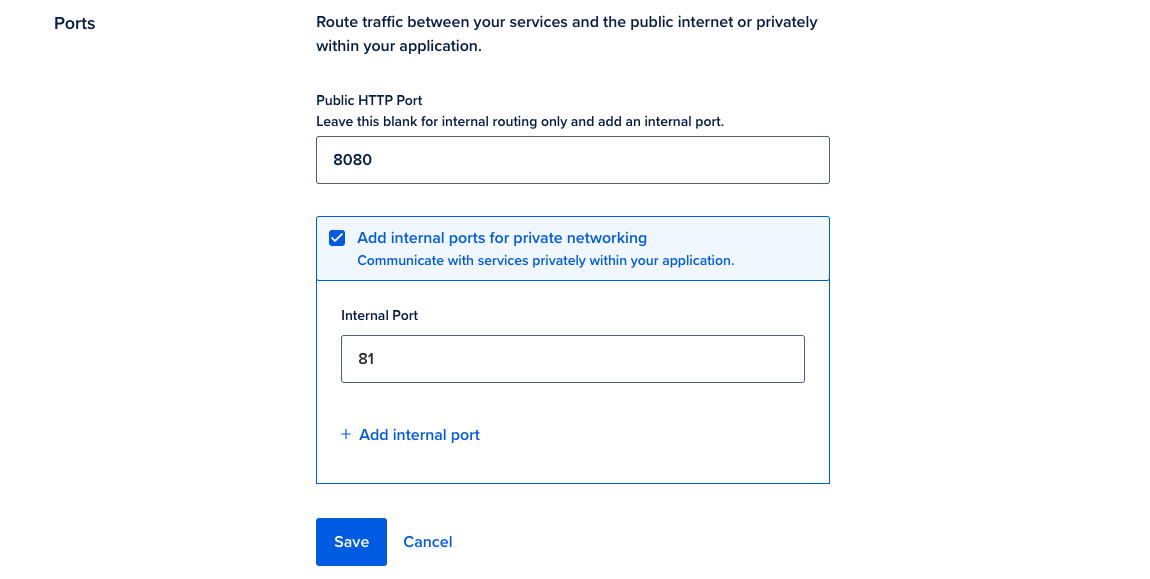0.0.0.0 , rather than on the localhost (localhost) or loopback interface (127.0.0.1).
Validated on 24 Feb 2024 • Last edited on 17 Jun 2025
App Platform is a Platform-as-a-Service (PaaS) offering that allows developers to publish code directly to DigitalOcean servers without worrying about the underlying infrastructure.
The usual app creation process will create a service by default; you only need to follow this process if you’re creating another resource for your app that needs an internet-accessible endpoint. If your resource only needs to be internally accessible, create a internal service instead. If you don’t need this resource to be internet-accessible, create a worker instead.
You can add a service to an app using the CLI’s app update command or the API’s app update endpoint. To add a service, update the app’s spec with the service’s specifications and submit the spec using the following command or endpoint.
In the Apps section of the DigitalOcean Control Panel, select your app. Click Add components, then choose Create resources from source code to add a Web Service.

On the Choose a deployment source screen, select the code repository service your app resides on. If you have not previously created an app on App Platform, the repository service prompts you to provide DigitalOcean with read permissions to your account.

Select the app's repo from the Repository drop-down and then select the branch to deploy from in the Branch drop-down menu.
The Source Directory is the directory inside the repo from which to build the app. The default is the repo's root directory. If you're deploying from a monorepo or a container image registry, see Deploy from a Monorepo or How to Deploy from Container Images for more information on how to deploy apps using these options.
You can choose to opt out of auto-deploying code changes. Uncheck the Autodeploy box to disable App Platform from redeploying the app when it detects changes in the app's repo.
Once you have selected the app's repo and branch, click Next. App Platform retrieves your app's code.
App Platform inspects the code and app resources and selects an appropriate runtime environment (such as Node or Ruby). If you need to override this, upload a Dockerfile to your branch and restart the app creation process.

To change to a different resource type, in the Info section, click Edit. Use the Resource type drop-down menu to choose another option.
In the settings page, you can also change the resource’s name, view the resource’s buildpacks, edit its build and run commands, edit the HTTP port and the request route, and more.
App Platform also displays the settings for the component, several of which may be auto-filled by App Platform's detection system. You can configure the following settings for your app:
Name: A unique name for the component.
Resource Type: The type of app to be deployed, either a web service, static site, or worker service. This field determines which additional configuration options are available for your app on this screen.
Instance Size: The amount of memory (RAM), number of CPUs, and bandwidth allocated to the component. You can select a size that uses either shared or dedicated CPUs. Shared CPUs share their processing power with other DigitalOcean users. Dedicated CPUs are dedicated solely to your app. We recommend dedicated CPUs for more resource-intensive applications that require consistent high performance and autoscaling.
Containers: You can also configure your app's scaling settings in this section. Depending on what instance size you select determines the scaling options available to the component. For more information about scaling, see How to Scale Apps in App Platform.
Build Strategy: Add a custom build command to run before the app is deployed. This is useful for compiling assets, installing dependencies, or running tests before deployment.
Run Command: For web and worker services only. You can specify custom run commands for the application to run after deployment. If no run commands are specified, the default run command for your app's language is used, such as npm start for a Node.js app. For Dockerfile-based builds, entering a run command overrides the Dockerfile's entrypoint.
Public HTTP Port: For web services only. The port that the app receives HTTP requests on. The default port is 8080.
Internal Ports: For web services only. The port that the app receives internal requests on.
HTTP Request Routes: For web services and static sites only. The URL path where the app can be accessed, such as your-app-v3cl4.ondigitalocean.app/api. If not specified, the app is accessible from the provided hostname's root.
Output Directory: For static sites only. An optional path to where the build assets are located, relative to the build context. If not set, App Platform automatically scans for these directory names: _static, dist, public, build.
App Platform uses cloud-native buildpacks to build your app and uses the buildpack's default build and run commands. Refer to the cloud-native buildpack reference for more information about specific buildpacks.
If your app requires environment variables, such as the app's URL or database connection strings, you can define them in this section. These can be runtime and build time environment variables. We also provide several app-specific dynamic environment variables that the app can reference. App-level variables can be accessed by all resources in your app.
In the App-level environment variables box, click the corresponding Edit link to specify app-level or component-level environment variables. Click the Encrypt checkbox to obscure the variable's values from all build, deployment, and application logs.
Once you configure the environment variables, click Add resources.
0.0.0.0 , rather than on the localhost (localhost) or loopback interface (127.0.0.1).
Full HTTP request path preservation for services is not available in the control panel. Instead, set the preserve_path_prefix annotation in the App Spec to true.
In the Apps section of the DigitalOcean Control Panel, select your app and click the Settings tab. Click the Web Service you'd like to edit.
You can use the configuration settings you see here to change the Web Service's scaling behavior, modify environment variables, edit commands, and more.
In the Apps section of the DigitalOcean Control Panel, select your app and click the Settings tab. Click the Web Service you'd like to destroy.
You can destroy the Web Service by clicking the Destroy Component button on the bottom of the page and entering its name to confirm your selection.
Internal services are accessible to other components in the app’s private network. They do not have ports or endpoints exposed to the public internet.
You can create an internal service by closing the ports on an existing service or by updating an app’s spec with the internal_ports field.
To create an internal service from the control panel, click your app and then click the Settings tab. From the Settings tab, select the service you want to make internal, scroll down to the Ports section, and then click Edit.

In the Ports section, leave the Public HTTP Port field blank to close the public port. Then click the Add internal ports for private networking checkbox and add the internal port you want to open in the Internal Port field. You can add additional internal ports by clicking Add internal port and repeating this step.
Once you have specified the ports you want to add, click Save. This redeploys the app with the new internal ports.
To create an internal service using the app spec, remove any existing http_port fields from the target service object and then add the internal_ports field to the service:
app.yamlservices:
- environment_slug: go
github:
branch: master
deploy_on_push: true
repo: digitalocean/sample-golang
instance_count: 1
instance_size_slug: apps-s-1vcpu-1gb
internal_ports:
- 8080
name: internal-service
run_command: bin/sample-golangThe example service above is an internal service because it has no HTTP port or route, so it is inaccessible from the public internet, but exposes port 8080 internally, so workers and other services can reach it.
To add Functions, adjust your app spec like so:
name: go-random
region: nyc
functions:
- name: go-api
github:
repo: digitalocean/sample-functions-golang-random
branch: master
deploy_on_push: trueThis process requires you to authorize to GitHub and specify the region you want to create the Function in. You can also delete the region field to automatically create the Function in the datacenter closest to you.
Try using different keywords or simplifying your search terms.